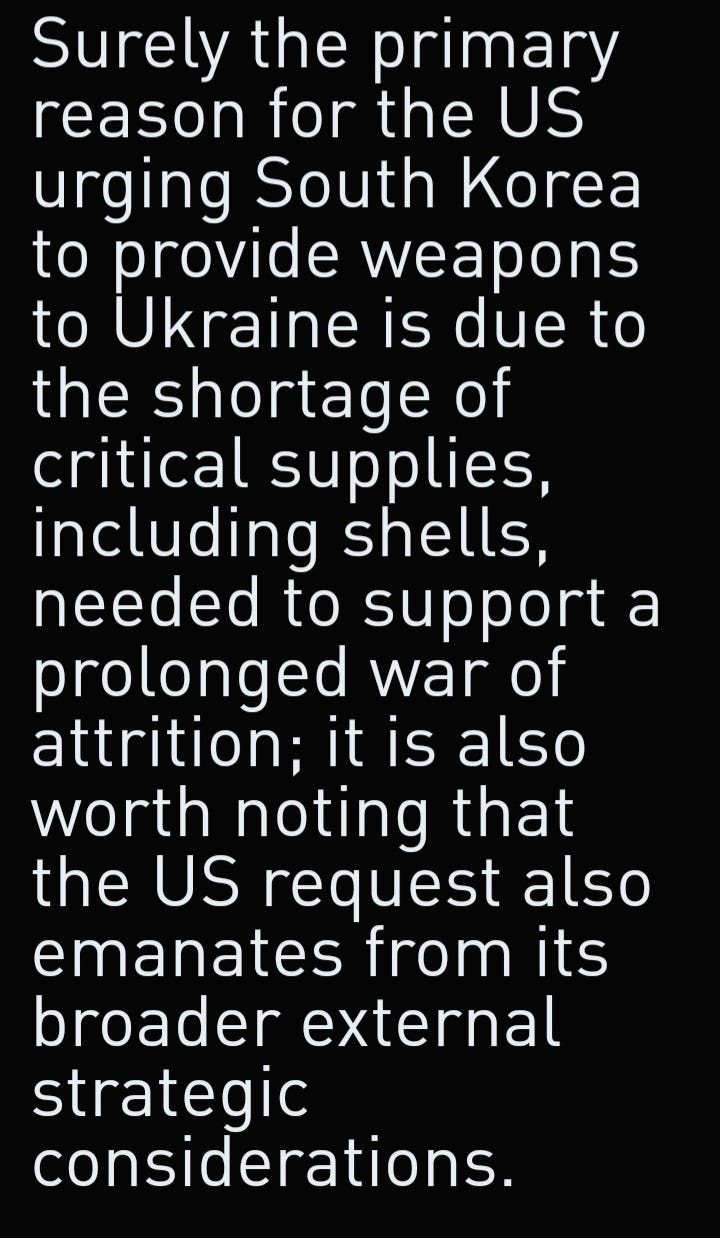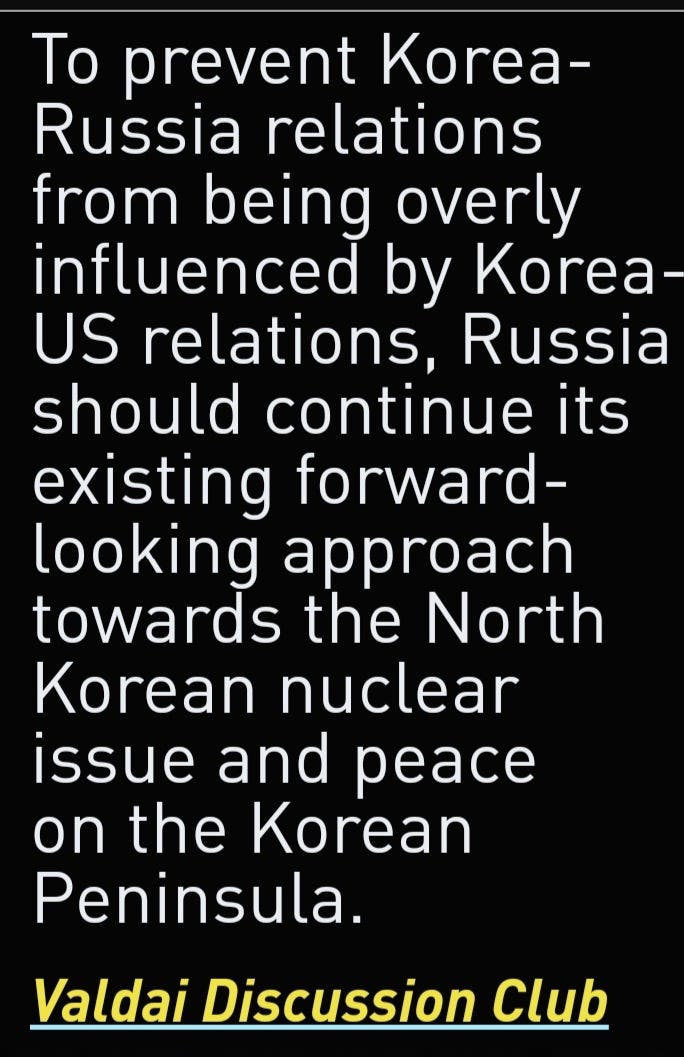collective on foreign affairs
6/06/2023
While the United States of America is seeking to integrate NATO more closely the Asia countries into AUKUS and QUAD, she is simultaneously strengthening cooperation between South Korea and Japan, too.
In this perspective, Washington preferably wants South Korea to establish links with NATO through arms support to Ukraine.
South Korea, President Yoon Suk-yeol had expressedly stated on 24th. April 2023:
“If there is a situation the international community cannot condone, such as any large-scale attack on civilians, massacre or serious violation of the laws of war, it might be difficult for us to insist only on humanitarian or financial support.”
Although Yoon has also emphasised that it would only be a conditional weapon support. To some observers, the statement was highly symbolic because it marked the first time that Seoul has implied a willingness to send weaponry to Ukraine. This was regarded as of significance given that Seoul has often rejected this venture, and consistently dismissed such notions in the past, within a foreign policy that is maintaining a stance against providing lethal arms to countries during or in destabilising conflicts.

There are also other various geostrategic reasons for this changing positioning.
Firstly, the US views the conflict between the US and Russia caused by the Ukrainian war as gradually being integrated into the framework of competition between the US and China, (RAND Corp, Jan. 2020).
It is also a dual strengthening of the linkage between its security strategies towards Europe and those towards the Asia-Pacific region.
If the war in Ukraine persists amidst the deepening US-China rivalry, it will be challenging for the US to concentrate its power on the Indo-Pacific strategy. Specifically in the Asia-Pacific region, if any conflict arises, it needs to be noted that armed clashes may occur simultaneously in multiple conflict zones, such as the South China Sea, the East China Sea, Taiwan, the Korean Peninsula, etc., unlike in Europe.Moreover, the lack of a multilateral security framework like NATO will render the US response more complicated than in Europe.
Therefore, not unsurprisingly, the concern in integrating security between Europe and the Asia-Pacific region is an imminent task for the United States.
Secondly, the United States intends to block Russia’s New Eastern Policy, which Russia has implemented since the 2012 APEC summit. The reasons behind Russia’s reinforcement of its New Eastern Policy are as follows:first: Russia acknowledged that enhancing its leverage by strengthening economic cooperation with North Korea and supporting the regime is vital for expanding its influence in Northeast Asia, as a response to Western attempts to isolate Russia internationally.
second: Russia has recognized the need to respond to the US pivot to Asia, particularly the US Indo-Pacific strategy.
Then, from another angle, Russia’s need for an alternative Asian market to replace the European energy market has also grown.
With this awareness, Russia has elevated its strategic cooperation with China to the highest level, while strengthening energy cooperation with Japan through the northern territorial issue and highlighting trilateral cooperation with South Korea on the North Korean nuclear issue.It is this new pivoting by Russia in recognising that increased economic cooperation between South Korea and Russia, as well as between Japan and Russia, could potentially undermine its Indo-Pacific Strategy, that the US is very concern this positioning may risk causing irreparable damage to both Sino-Japanese and South Korea-Russia relations.
One can say that the reaction from Russia seems to be driven by concerns that South Korea has been indirectly supporting Ukraine through the export of weapons. In 2022, South Korea signed a contract with Poland to export K2 tanks, K9 howitzers, and Chunmu multiple launch rocket systems (MLRS), raising concerns that these weapons may be offered finally to Ukraine. Furthermore, there were news reports that South Korea may indirectly export 500,000 155mm artillery shells to the US for use in Ukraine.
Further, during the month of February 2023, the Korean government had expanded its list of export control by adding 741 new items to the existing 57 non-strategic item list that had already been restricted since March of last year.
It has to be emphasised that security tensions in Northeast Asia are likely to increase in the future, making it more challenging to establish effective problem-solving mechanisms. Even when North Korea escalates its provocations, achieving international consensus on UN sanctions against it will not be easy.
Then, directly encouraging South Korea to adopt a nuclear deterrent posture, there are visible threads instigating on this direction. It is said that in various South Korea public debate over developing nuclear weapons has since gained unprecedented attention after President Yoon’s comment in January 2023 about the possibility of South Korea going nuclear. It is even presented that polls in South Korea have shown the percentage of domestic support for “the acquisition of nuclear weapons ranging between the high 60s and mid-70s“, (Jennifer Ahn of CfR, 3/6/2023).
The factors driving the South Korean public’s sentiment include concerns over the US extended deterrence commitment and whether the United States would defend South Korea if North Korea were to simultaneously threaten the US mainland. Advocates of nuclearisation also call for nuclear balance with North Korea’s nuclear arsenal and greater autonomy and agency over South Korea’s ability to defend itself in the face of growing regional and global security challenges.
It is under such emerging South Korea domestic sentiment that President Biden and South Korean President Yoon Suk Yeol have recently agreed to allow U.S. nuclear-armed submarines to dock in South Korea for the first time in 40 years, (csmonitor, April 2023 ). The agreement was seen as a way to ward off South Korea from restarting its own nuclear program – but realigning more favourably to the US geostrategic outlook in containing China by encouraging South Korea to be integrated as part of the present Europe security concern.
Looking at the broader perspective, as an inseparable element regarding American dominance, in 1965, Thomas Hughes of the U.S. State Department of Intelligence and Research authored an important memorandum, ‘The Significance of NATO—Present and Future’. NATO, Hughes wrote, ‘remains essential to the U.S. as a well-established and easily available instrument for exercising American political influence in Europe’ and ultimately ‘it is important for the protection of American interests in Europe’.
Then, there is the other politico-economic issue in that the US may be unwilling to tolerate South Korea’s efforts to envision a small-scale multilateral cooperation system involving China and Russia.
As a result, the Korean government is facing more difficulties in pursuing practical and balanced diplomacy; its Indo-Pacific Strategy is too wide-spreading, and diluted in policy focused, (see firesstorms, May 2023, South Korea’s Indo-Pacific Strategy).
From the Russian perspective, her global affairs outlook would thus be:

adapting framework of the Valdai Papers